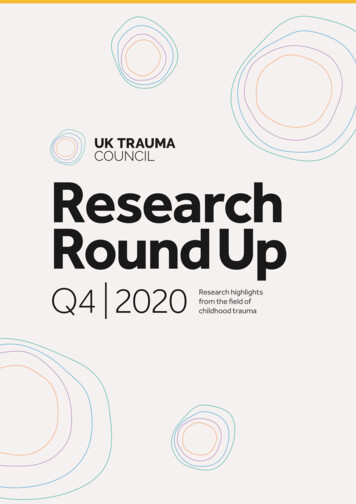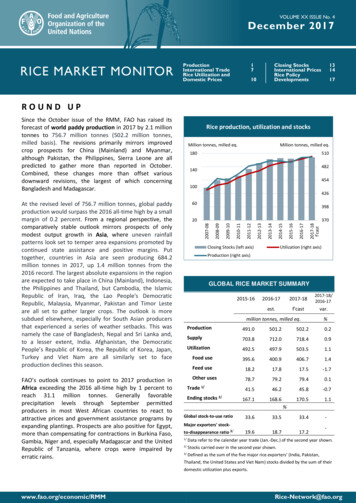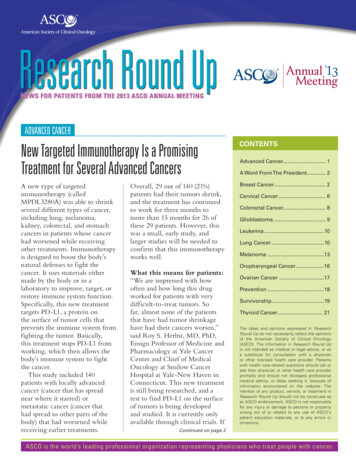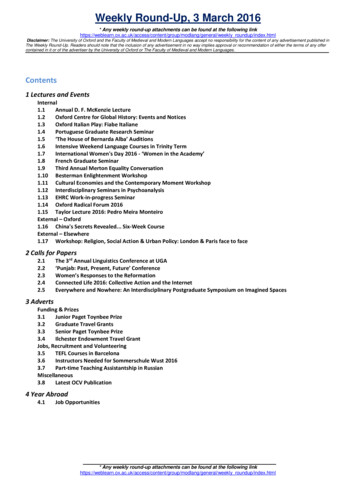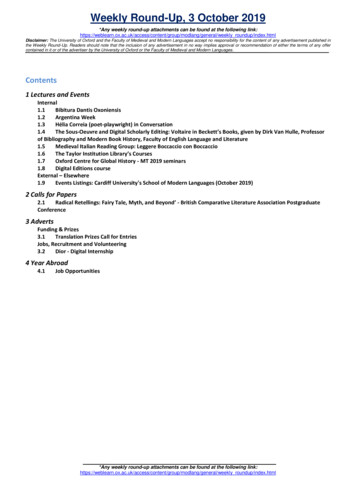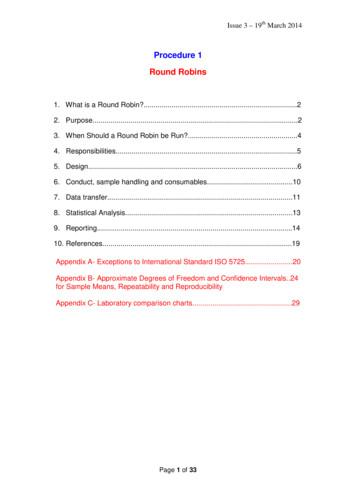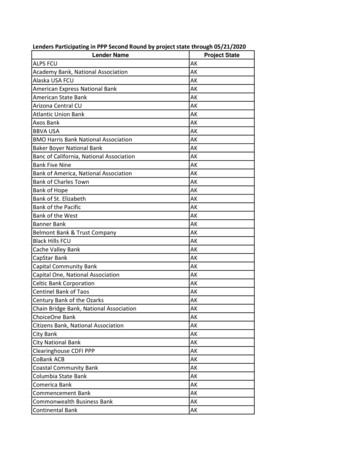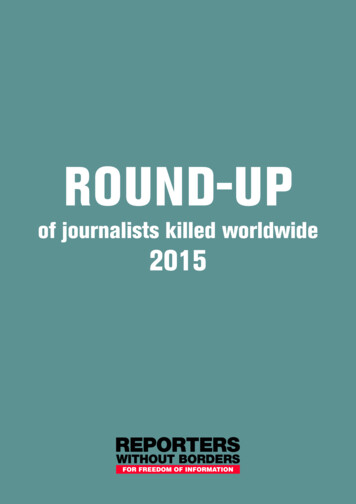
Transcription
ROUND-UPof journalists killed worldwide2015
2015ROUND-UP OF JOURNALISTSKILLED WORLDWIDERound-up at 28 december 2015CONTENTS110 journalists killed 5 deadliest places 5 atrocities that marked 2015 Journalists in prison or held hostage Giving journalists better protection To help protect journalists,RSF launches its newSafety Guide in partnershipwith Unesco.SAFETY GUIDEFORJOURNALISTSA handbook for reporters in high-risk environmentsUnited NationsEducational, Scientific andCultural Organizationreporters without borders1reporters without borders1p. 3p. 5p. 7p. 9p. 10
PROFESSIONAL JOURNALISTS KILLEDTEDERGAT43KILLEDNCLEAR REASRUONSFORED OR KNOWEDRINGUMLY491106718 KEIL L E D IN T HRKOURWCOSE OF T H EIRAt least 787 journalists have been killedin connection with their work since 2005110857564MURDERED OR KNOWINGLY TARGETED:deliberately killed because of their work8787607167586667KILLED IN THE COURSE OF THEIR WORK:killed while reporting without being targeted as journalistsKILLED FOR UNCLEAR REASONS:RSF has not been able to establish with certainty that theywere targeted as 420153 / ROUND-UP OF JOURNALISTS KILLED WORLDWIDE
110JOURNALISTS KILLED IN 2015 27 citizen-journalists 7 media workersJournalists knowingly targetedor killed while reporting36%in warzones64%outsidewar zones97%nationals3%foreignersPress2 women1 in Somalia1 in FranceThe very high number of journalists killed in 2015 (bringing to 787 the total killed since 2005 in the courseof their work or in connection with it) is attributable to the increasingly deliberate use of violence againstjournalists. It is also indicative of the failure of initiatives designed to protect journalists. United Nationssecretary-general Ban Ki-moon said on 6 August 2015 in his annual report on the safety of journalists andthe issue of impunity: “I am deeply concerned about the failure to reduce the frequency and scale of targetedviolence that journalists face and the near absolute impunity for such crimes.”Non-state groups perpetrate targeted atrocities while too many governments do not comply with theirobligations under international law. Addressing the UN Security Council on 27 May 2015, RSF secretarygeneral Christophe Deloire called for the creation of a specific mechanism for enforcing international law onthe protection of journalists, without which Resolution 2222, like Resolution 1738 in 2006, could end up beinga good resolution and nothing more.Two thirds of the journalists killed worldwide in 2014 were killed in war zones. In 2015, it was the exactopposite. Two thirds were killed in countries “at peace.” Journalists can even be killed in capitals far fromarmed conflicts, as we saw in the Charlie Hebdo attack in Paris on 7 January. Charlie Hebdo publisher Risssaid on 8 October: “We almost never sent journalists to war zones (.) On 7 January, war came to us.”Killed in connection with their work as journalists? In the cases of 43 of the journalists killed in 2015, themotives or reasons for their deaths remain unclear because of the lack of thorough and impartial officialinvestigations, the lack of good faith on the part of governments, or the difficulty of investigating in unstableor lawless regions. These “unclear reasons” reflect the problem of impunity for crimes of violence againstjournalists in many regions of the world (Latin America, Asia-Pacific, Middle East and sub-Saharan Africa).4 / ROUND-UP OF JOURNALISTS KILLED WORLDWIDE
5DEADLIEST PLACES FOR JOURNALISTSIraq1192Syria1091France88Yemen862South ILLED IN THE COURSE OF THEIRWORK OR MURDERED OR KNOWINGLYTARGETEDKILLED FOR UNCLEAR REASONSThe Charlie Hebdo attack made France the third deadliest country for journalists in 2015. It was anunprecedented tragedy. A western country had never suffered a massacre of this kind in the past. CharlieHebdo’s journalists and employees have been living under close protection ever since. Some of them still haveto keep changing their place of residence. In May, the Charlie Hebdo journalist who covers religious issues andIslamism said she lived part of the time in hotels and the rest of the time with relatives. She said it was veryhard to work while facing threats of this kind, and that it was impossible to do reporting with a police escort.In Aleppo (northern Syria), journalists caught in crossfireWhat with Bashar al-Assad’s forces, militant groups, Kurdish groups and coalition air strikes,the Syrian city of Aleppo is a minefield for professional and citizen-journalists. Caughtbetween the various parties to the conflict since 2011, journalists are liable to end up ascollateral victims, being taken hostage by a non-state group (such as Islamic State, the AlNusra Front or the Free Syrian Army) or being arrested by the Assad regime.Mosul, city controlled by Islamic StateUnder the control of Islamic State (Daesh) since June 2014, the northern Iraqi city of Mosulis an “information black hole.” In this city alone, the Jihadi group has been responsible for48 abductions and 13 executions of journalists and citizen-journalists in the past 18 months.Around 60 professional and non-professional journalists and media workers have fled thecity, while those that are still there cannot work for fear of reprisals. Disinformation reignsin this environment. Contact with the outside world is banned or restricted by IS, which alsocontrols communications and the Internet.5 / ROUND-UP OF JOURNALISTS KILLED WORLDWIDE
Yemen: Houthi militias sow terror in SanaaAfter a rapid advance through northern Yemen, Houthi rebel militias seized control of thecapital, Sanaa, in September 2014. Thereafter they attacked media outlets with heavyweapons and abducted journalists affiliated to Al-Islah (a Sunni Islamist coalition opposedto the Zaydi-Shia Houthis). More than a year later, the only journalists still working in Sanaaare those that support the Houthi rebel militias. Six journalists and three media workers weremurdered or killed in the course of their work in Yemen in 2015. At least 15 professionaljournalists, citizen-journalists and media workers are currently believed to be held by theHouthis, who are continuing their southward advance. Those not being targeted by theHouthis are exposed to air strikes by the Saudi-led coalition that is trying to halt the Houthiadvance.India: mounting violence from organized crimeIndian journalists daring to cover organized crime and its links with politicians have beenexposed to a surge in violence, especially violence of criminal origin, since the start of 2015.Nine journalists have been murdered in the past year (four of them for still undeterminedreasons). Their deaths confirm India’s position as Asia’s deadliest country for mediapersonnel, ahead of both Pakistan and Afghanistan. Two of the murders monitored by RSFwere linked to illegal mining, a sensitive environmental subject in India. The inadequacy ofthe Indian authorities’ response is reinforcing the climate of impunity for violence againstjournalists. After the murder of Sandeep Kothari (the eighth journalist to be killed for workrelated reasons in two years), RSF urged the government to establish a national plan forprotecting journalists. A response that matches the scale of the threats to journalists is nowessential.In Mexico, no refuge possible for journalistsMexico continues to be Latin America’s deadliest country for journalists, with eight killed in2015 (five of them for still unclear reasons). The most dangerous regions are the southernstates of Veracruz and Oaxaca, where organized crime and local politicians target reportersas soon as they start covering corruption. Journalists used to be able to flee these states andseek refuge in calmer parts of the country but Rubén Espinosa’s murder in Mexico City on31 July after fleeing from Veracruz showed that there is no longer any safe place in Mexicofor threatened journalists.6 / ROUND-UP OF JOURNALISTS KILLED WORLDWIDE
5ATROCITIES THAT MARKED 20152015Attack on Charlie Hebdo (France)Two heavily-armed masked men, Saïd and Chérif Kouachi, marched into Charlie Hebdo’sheadquarters in Paris on 7 January and gunned down 12 people, including eight journalists –cartoonists Charb, Cabu, Tignous, Wolinski and Honoré and reporters Elsa Cayat, MustaphaOurad and Bernard Maris. Two days later, Al-Qaeda in the Arabian Peninsula (AQAP) saidit carried out the attack to “avenge” the Prophet Mohamed, often the subject of CharlieHebdo’s satirical cartoons. Instigated by an extremist ideology that does not tolerateblasphemy, the attack underscored the need to combat the concept of “defamation ofreligion.”CharbCabuTignousWolinskiHonoréElsa CayatMustapha OuradBernard MarisStaged murder of Kenji Goto (Syria)On 31 January, Islamic State released a video of Japanese freelance reporter Kenji Goto’sexecution. Goto had been captured in late October 2014 while trying to cover the fightingin Syria and locate Haruna Yukawa, a Japanese journalist who was executed a weekbefore Goto. In a macabre performance similar to previous executions of foreign journalists,the video showed a masked executioner address the Japanese prime minister directly,announcing that Goto’s execution was a reprisal for Japan’s participation in the internationalcoalition against Islamic State. Non-state groups are currently holding ten foreign journalists(journalists who are not citizens of the country where they were captured).7 / ROUND-UP OF JOURNALISTS KILLED WORLDWIDE
Shocking massacre of bloggers (Bangladesh)Four bloggers were hacked to death in Bangladesh in 2015. The victims – Avijit Roy on26 February, Ananta Bijoy Das on 30 March, Washiqur Rahman on 12 May and NiloyChakrabarti on 7 August – were all secularists who advocated tolerance, free speechand freedom of thought in their blogs. Responsibility for their murders was claimed byAnsar al-Islam (a branch of Al-Qaeda in the Indian Subcontinent) and Ansarullah BanglaTeam, another militant group. The passivity of the Bangladeshi authorities in the face ofthis bloodbath has fostered a climate of impunity that is extremely dangerous for citizenjournalists. The perpetrators and instigators of these appalling crimes have yet to be arrestedand brought to justice.Avijit RoyAnanta Bijoy DasWashiqur RahmanNiloy ChakrabartiFugitive journalist Rubén Espinosa’s murder (Mexico)Photojournalist Rubén Espinosa and four women were found dead on 31 July in anapartment in Mexico City, to which Espinosa had fled after receiving death threats in thesouthern state of Veracruz. His body bore the apparent marks of torture. His murderprompted outrage and realization of the almost complete absence of effective protection forjournalists. A law on the protection of journalists took effect ten days later (on 10 August) inMexico City. It was the result of several years of consultation with civil society but will havelittle impact until it is extended to other parts of the country and adequate resources areassigned to its implementation.Hindiya Mohamed, latest media victim (Somalia)A Somali national radio and TV journalist, Hindiya Mohamed was one of the two women tobe killed this year because of their media work. She was fatally injured by a bomb plantedin her car in Mogadishu on 3 December. Her death bore the hallmarks of an operation bythe Islamist rebel militia Al Shabaab. Her husband, fellow journalist Liban Ali Nur, was killedin a September 2012 bombing claimed by Al Shabaab. The impunity for crimes of violenceagainst journalists in Somalia just encourages more murders of this kind. RSF has repeatedlyurged the Somali authorities to ensure that these attacks are investigated in a thorough andindependent manner so that those responsible are brought to justice. But journalists’ safetyis still not a priority for the government.8 / ROUND-UP OF JOURNALISTS KILLED WORLDWIDE
JOURNALISTS IN PRISON OR HELD HOSTAGE23 China22 Egypt18 Iran26 Syria9 Turkey26 Syria13 Yemen66 Restof the world13 urkeyRest of the worldRest of the worldJOUN5454JOURRANALISLISTSTS15 EritreaTAGESOSHD HOSTAGESLHEELDH153 JOURNSTILASDEDETATAININEDED5 LibyaED10 IraqTAIN13 YemenOSTAGESHLDEHDE26 Syria54 JOURNALISTS2015For more information aboutviolence against journalists,see the round-up ofjournalists held hostage,detained or reported missingin 2015STIS TSLA1 5 3 J O U R N A LI S153 JOURN9 / ROUND-UP OF JOURNALISTS KILLED WORLDWIDE
GIVING JOURNALISTS BETTER PROTECTIONRSF has addressed several recommendations to the UN secretary-general,the UN Security Council and the UN General Assembly for improving themechanisms for protecting journalists throughout the world.The UN should create the position of special representative of the secretary-general for thesafety of journalists. Tasked above all with monitoring compliance by UN member states with theirobligations under international law, the special representative would have the political weight and earlywarning capability that are necessary to protect journalists effectively. With the aim of quickly obtaininga resolution creating this position, RSF has been waging an active international campaign for severalmonths to gather support within the UN system and from member states.The UN Security Council should refer war crimes against journalists to the InternationalCriminal Court (ICC). On 27 April 2015, RSF asked the Security Council to do everything possibleto ensure that the situation of journalists in Syria and Iraq is referred to the ICC prosecutor. Only theSecurity Council, under its authority for maintaining international peace and security, can get the ICCto investigate war crimes against journalists in countries that are not parties to the ICC statute, and toprosecute those responsible.About RSFReporters Without Borders (RSF) promotes and defends freedom of information
3 / ROUND-UP OF JOURNALISTS KILLED WORLDWIDE 1 8 N KI LE D I T H E C O U R S E OF T H I W O R 4 9 M U R D E R E D E O R K N O W I N G L Y L T A R G E T E D 4 3 K I L E D F O R U N C L A R R E A S O N S 67 110 PROFESSIONAL JOURNALISTS KILLED At least 787 journalists have been killed in connection with their work since 2005





